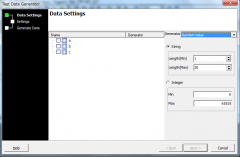
- Sample data generator generator#
- Sample data generator manual#
- Sample data generator full#
- Sample data generator free#
Specify the number of entries to generate. From the menu, select Custom, then select the newly created generator. In a text file or a text block, press Alt+Insert. For example, if a single entry generated by the expression is a JSON object, these settings will combine such objects into a higher level structure (for instance, an array). These will apply to each expression result, when multiple entries are generated. Within the expression, you can use any of the predefined variables as well as custom dictionaries and regular expressions that have been assigned a variable name. It will be used to generate individual entries. Once you have one, you can skip the configuration step.Īdd a new generator, give it a name, and select Multiple for the type.
Sample data generator full#
The steps below cover the full procedure that includes creating a template. In order to generate multiple entries, you have to create a custom template.
Sample data generator generator#
The Test Data plugin allows you to create a custom generator that handles bulk data generation and custom formats. If you need to generate multiple entries in a specific format, that's also possible. You can use them to generate literals just like with the predefined generators. Otherwise, you may leave this field blank.Īfter you have specified a custom dictionary or a regex, they appear in the Generate menu under Custom. You can later use this name to refer to this dictionary. If you want to use this regex in a complex generator, for example to generate massive amounts of data in an arbitrary format, specify the Variable name. You can preview an example of the generator output in the Result tab. Specify a regex for test data generationĪdd a new generator, give it a name, and select Regex for the type.Įnter the regular expression in the Expression field. To use them, you have to create a regex-based generator. The Test Data plugin also supports regular expressions. Otherwise, you may leave this field blank.

If you want to use this dictionary in a complex generator, for example to generate massive amounts of data in an arbitrary format, specify the Variable name. This site can be used for a variety of purposes, including psychology experiments, medical trials, and survey research.
Sample data generator free#
Specify the dictionary entries in the Expression field. RANDOM SAMPLING AND RANDOM ASSIGNMENT MADE EASY Research Randomizer is a free resource for researchers and students in need of a quick way to generate random numbers or assign participants to experimental conditions. From the menu, select Custom, then Configure Custom Data Generators.Īdd a new generator, give it a name, and select Dictionary for the type. In addition to predefined dictionaries, you can use a custom one. The generated literal appears at the caret.įrom the menu, select the type of data that you want to generate. Place the caret where you want to generate a literal and press Alt+Insert. To use the tools covered in this section, make sure that the Test Data plugin is installed and enabled. You can quickly insert a single entry or use more advanced options to generate massive files in CSV, JSON, or any other custom format. This might be names, dates, email addresses, hostnames and so on. The generator createdĭefault values based on the rules defined in the XSD in order to create an XML document that conforms to the source XML Schema.Some tests rely on test data, and IntelliJ IDEA can generate this data for you. This following XML document was generated by the XML Sample Generator from the Bookstore.xsd (above). Being able to generate sample XMLĭocuments can save huge amounts of time when creating your test data, as it provides the skeletal message, making it easy for meaningful test Testing an application is all about having good test cases, and good test cases need good test data.

Furthermore when writing XML from an application, it is useful to have a clear idea of what the XML should look like, samples make it much easier to see where the applications output differ from the test cases.įor reading and writing XML from an application see XML Data Binding.

Sample data generator manual#
In the early stages of a development project such examples can be thin on the ground, so being able to generate them can save hours of manual typing. When tasked with reading an XML document into an application, it is useful to have a good set of valid test cases to work from. This allows you to quickly see any unexpected artefacts in the XML document. The XML Sample generator takes an XML Schema and generates random sample XML documentsīased on your XSD. The XML Schema diagrams make it clear what the structure is, but it is sometimes easier to see an example of an actualĭocument in order to get a clear picture. While designing XML Schemas (XSD) it is often useful to be able to see what the resulting XML documents will look like.


 0 kommentar(er)
0 kommentar(er)
